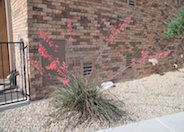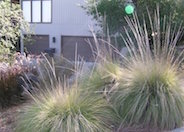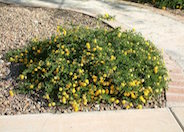
Common name:Pinon Pine, Pinyon or Nut Pine
Botanical name:Pinus edulis
This slow-growing, small conifer has dark green pairs of needles and is a stately tree. Its cones produce edible pine nuts.

Common name:Bi-colored Hesperaloe
Botanical name:Hesperaloe parviflora 'Duet'
Spectacular accent for desert gardens anywhere. Plants tolerate drought, full sun, reflected heat, and poor soils. Forms rosettes of leaves 4' x 6'. The red and yellow flower stalks emerge in spring and remain on the plant until the end of summer. - Mountain States Nursery

Common name:Deer Grass
Botanical name:Muhlenbergia rigens
Mounding grass that grows quickly to 4' x 4'. Leaves are medium green and turns tan in fall. Tall flower spikes appear in fall they start out green and dry to tan. Accepts full sun or partial shade. Very frost tolerant. This is a versatile grass with lush foliage and interesting flowers. Great for softening a landscape. Native to the southwest U.S. and Mexico.

Common name:Lantana
Botanical name:Lantana 'Dwarf Yellow'
This small shrub will reach 3' tall at the most and has small, dark green leaves with yellow flowers that are in constant bloom throughout the year.

Common name:Capital Columnar Callery Pear
Botanical name:Pyrus calleryana 'Capital'
The 'Capital' assumes a hardy, columnar form with thick, glossy green leaves that change from a red to a purple color in the fall. White flowers are borne in the spring. It reaches a size of 30' high by 7'-8' wide, and is a good tree where space is limited.
| Designer: Jennifer Barr | Barr Gardens 13 |
Photographer: GardenSoft |
Soils and Compost:
Incorporate compost 6" into your soil to retain water, reduce compaction, feed earthworms, and provide valuable nutrients to your plants.
Water Saving Tip:
Different areas of your landscape have different water requirements.
Shrubs need much less water than lawns and drip systems should never be scheduled on the same program with lawns.
Establish separate watering schedules for those areas.
Integrated Pest Management:
Remove irrigation water and fertilizer from areas where you don't want weeds to grow.
